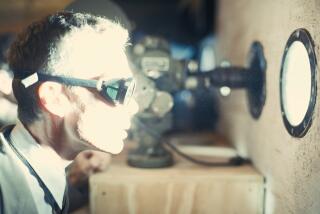Secret Unit : Targeting Nuclear Terrorism
- Share via
LAS VEGAS — Undercover scientists headquartered in Nevada are on 24-hour standby to track terrorist-built nuclear weapons that could hold a nation hostage.
The names of the scientists are classified. Their assignment is secret. They are members of NEST--Nuclear Emergency Search Team.
Scientists from at least 18 academic disciplines can be deployed within two hours to any domestic or international nuclear terrorist target. They have the equipment and expertise to locate and disarm improvised nuclear bombs or radioactive material.
An international terrorism task force recently warned that NEST may not be enough.
Headquartered in Las Vegas
The Department of Energy acknowledges that NEST is headquartered in Las Vegas but declines further comment.
NEST was created by executive order of President Gerald R. Ford in 1974 after an extortionist threatened to detonate a nuclear bomb in Boston and demanded $200,000.
The bomb threat was a false alarm, but the scientists sent to Boston lacked the equipment and organization to cope with the emergency on short notice.
Ford created NEST--so secret an organization that Congress did not learn of its existence for three years.
In the event of a terrorist nuclear threat, the FBI acts as the SWAT team and NEST supplies the technicians. The Department of Energy Emergency Action and Coordination Team directs organization and deployment.
70 Terrorist Threats
The FBI has investigated more than 70 nuclear terrorist threats to date, said FBI information officer Lee Bonner in Washington. NEST responded in 20 of the cases, according to a federal source. All but one was a hoax.
The only known extortion case involving radioactive material occurred in 1979 when a disgruntled employee stole 150 pounds of low-enriched uranium from a General Electric fuel-processing plant in Wilmington, N.D. He demanded $100,000 in exchange for not revealing how easy it was to steal the radioactive material.
The FBI arrested the nuclear thief before NEST had a chance to find the missing uranium, which the extortionist disclosed was hidden in a field. Scientists said they would have located it within 48 hours.
NEST has searched for nuclear bombs in Los Angeles, Boston, Spokane and San Francisco. All were false alarms.
In 1975, an extortionist threatened to detonate an atomic bomb in New York City unless $30 million was delivered in small, unmarked bills. No one claimed the dummy ransom package that the FBI placed at the drop site.
Threat to Union Oil
That same year the Union Oil Co. of California in Los Angeles received a $100,000 extortion note claiming that a nuclear device concealed in one of the company’s properties would explode unless the money was paid.
Forty NEST members, armed with radiation detection equipment, concluded after three days that the threat was a hoax. The FBI captured the would-be extortionist.
The ability of NEST to respond quickly and effectively was proved in January, 1978, when the Soviet satellite Cosmos 954, carrying a nuclear reactor, slipped from orbit and headed toward North America.
The National Security Council approved a federal emergency response plan, code-named “Operation Morning Light,” in case radioactive debris fell on the United States.
By Jan. 22, all equipment was loaded on Air Force C-141 transports at bases in Washington, D.C., California and Nevada. Personnel were put on two-hour alert with suitcases packed for cold weather or the tropics.
The satellite came down Jan. 24 in the isolated Northwest Territories of Canada between Great Slave Lake and Baker Lake. Canadian Prime Minister Pierre Trudeau accepted an offer of U.S. assistance and NEST was deployed.
“We were flying the first search pattern 22 hours after we got the Canadian request,” a government spokesman in Las Vegas said.
The first fragment of radiation was discovered Jan. 26. More than 200 NEST workers were employed in a three-month search that eventually retrieved hundreds of radioactive pieces of the Soviet satellite--some as small as a pinhead--from a 20,000-square-mile area.
“Morning Light” was a real emergency that tested NEST skills and equipment. Secret exercises keep the unit well-honed.
The NEST budget has increased from $1.5 million a decade ago to $8.7 million this fiscal year, according to the Department of Energy.
Most of the money goes for equipment--planes, helicopters equipped with radiation detection pods, radiation monitors disguised in briefcases, pocket-size radiation monitors. Specialized modules housing mobile machine shops, computer centers, communication stations and photography laboratories are maintained for rapid deployment anywhere in the world.
A recent task force report said more is needed.
“NEST should be improved and expanded,” said the International Task Force on Prevention of Nuclear Terrorism, which released its report in June. “NEST would face a virtually impossible task if it had to find a nuclear weapon or container once shielded and concealed within a city.”
The task force recommended that all nations with nuclear weapons deployed within their borders form their own anti-nuclear terrorist teams and urged the creation of an international NEST.
More to Read
Sign up for Essential California
The most important California stories and recommendations in your inbox every morning.
You may occasionally receive promotional content from the Los Angeles Times.










